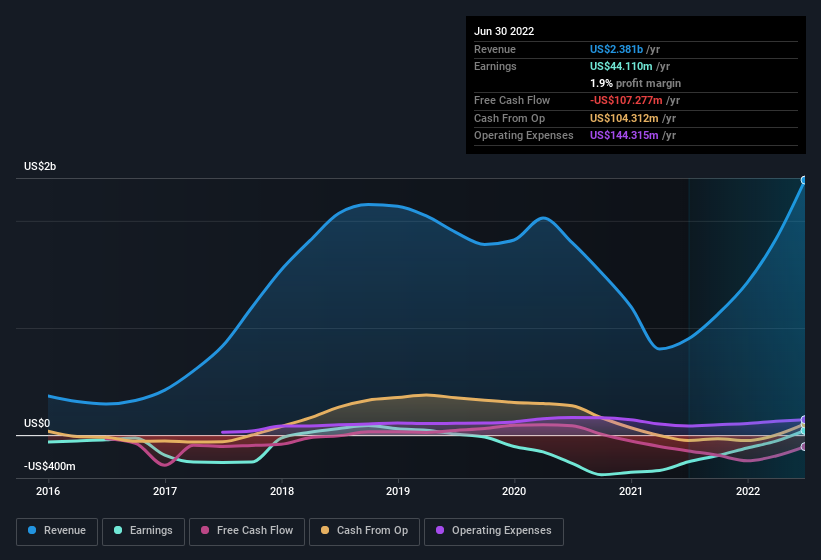- United States
- /
- Energy Services
- /
- NYSE:NEX
We Think That There Are Issues Underlying NexTier Oilfield Solutions' (NYSE:NEX) Earnings
Despite posting some strong earnings, the market for NexTier Oilfield Solutions Inc.'s (NYSE:NEX) stock hasn't moved much. We did some digging, and we found some concerning factors in the details.
Check out our latest analysis for NexTier Oilfield Solutions

A Closer Look At NexTier Oilfield Solutions' Earnings
Many investors haven't heard of the accrual ratio from cashflow, but it is actually a useful measure of how well a company's profit is backed up by free cash flow (FCF) during a given period. The accrual ratio subtracts the FCF from the profit for a given period, and divides the result by the average operating assets of the company over that time. The ratio shows us how much a company's profit exceeds its FCF.
As a result, a negative accrual ratio is a positive for the company, and a positive accrual ratio is a negative. While having an accrual ratio above zero is of little concern, we do think it's worth noting when a company has a relatively high accrual ratio. That's because some academic studies have suggested that high accruals ratios tend to lead to lower profit or less profit growth.
NexTier Oilfield Solutions has an accrual ratio of 0.21 for the year to June 2022. Therefore, we know that it's free cashflow was significantly lower than its statutory profit, which is hardly a good thing. Over the last year it actually had negative free cash flow of US$107m, in contrast to the aforementioned profit of US$44.1m. Coming off the back of negative free cash flow last year, we imagine some shareholders might wonder if its cash burn of US$107m, this year, indicates high risk. Notably, the company has issued new shares, thus diluting existing shareholders and reducing their share of future earnings. The good news for shareholders is that NexTier Oilfield Solutions' accrual ratio was much better last year, so this year's poor reading might simply be a case of a short term mismatch between profit and FCF. Shareholders should look for improved cashflow relative to profit in the current year, if that is indeed the case.
That might leave you wondering what analysts are forecasting in terms of future profitability. Luckily, you can click here to see an interactive graph depicting future profitability, based on their estimates.
One essential aspect of assessing earnings quality is to look at how much a company is diluting shareholders. NexTier Oilfield Solutions expanded the number of shares on issue by 13% over the last year. That means its earnings are split among a greater number of shares. Per share metrics like EPS help us understand how much actual shareholders are benefitting from the company's profits, while the net income level gives us a better view of the company's absolute size. Check out NexTier Oilfield Solutions' historical EPS growth by clicking on this link.
A Look At The Impact Of NexTier Oilfield Solutions' Dilution On Its Earnings Per Share (EPS)
As it happens, we don't know how much the company made or lost three years ago, because we don't have the data. Zooming in to the last year, we still can't talk about growth rates coherently, since it made a loss last year. But mathematics aside, it is always good to see when a formerly unprofitable business come good (though we accept profit would have been higher if dilution had not been required). And so, you can see quite clearly that dilution is influencing shareholder earnings.
In the long term, if NexTier Oilfield Solutions' earnings per share can increase, then the share price should too. However, if its profit increases while its earnings per share stay flat (or even fall) then shareholders might not see much benefit. For the ordinary retail shareholder, EPS is a great measure to check your hypothetical "share" of the company's profit.
Our Take On NexTier Oilfield Solutions' Profit Performance
In conclusion, NexTier Oilfield Solutions has weak cashflow relative to earnings, which indicates lower quality earnings, and the dilution means that shareholders now own a smaller proportion of the company (assuming they maintained the same number of shares). Considering all this we'd argue NexTier Oilfield Solutions' profits probably give an overly generous impression of its sustainable level of profitability. So if you'd like to dive deeper into this stock, it's crucial to consider any risks it's facing. Every company has risks, and we've spotted 2 warning signs for NexTier Oilfield Solutions (of which 1 makes us a bit uncomfortable!) you should know about.
Our examination of NexTier Oilfield Solutions has focussed on certain factors that can make its earnings look better than they are. And, on that basis, we are somewhat skeptical. But there are plenty of other ways to inform your opinion of a company. For example, many people consider a high return on equity as an indication of favorable business economics, while others like to 'follow the money' and search out stocks that insiders are buying. So you may wish to see this free collection of companies boasting high return on equity, or this list of stocks that insiders are buying.
Valuation is complex, but we're here to simplify it.
Discover if NexTier Oilfield Solutions might be undervalued or overvalued with our detailed analysis, featuring fair value estimates, potential risks, dividends, insider trades, and its financial condition.
Access Free AnalysisHave feedback on this article? Concerned about the content? Get in touch with us directly. Alternatively, email editorial-team (at) simplywallst.com.
This article by Simply Wall St is general in nature. We provide commentary based on historical data and analyst forecasts only using an unbiased methodology and our articles are not intended to be financial advice. It does not constitute a recommendation to buy or sell any stock, and does not take account of your objectives, or your financial situation. We aim to bring you long-term focused analysis driven by fundamental data. Note that our analysis may not factor in the latest price-sensitive company announcements or qualitative material. Simply Wall St has no position in any stocks mentioned.
About NYSE:NEX
NexTier Oilfield Solutions
NexTier Oilfield Solutions Inc., through its subsidiaries, provides well completion and production services in various active and demanding basins.
Flawless balance sheet and undervalued.
Similar Companies
Market Insights
Community Narratives




